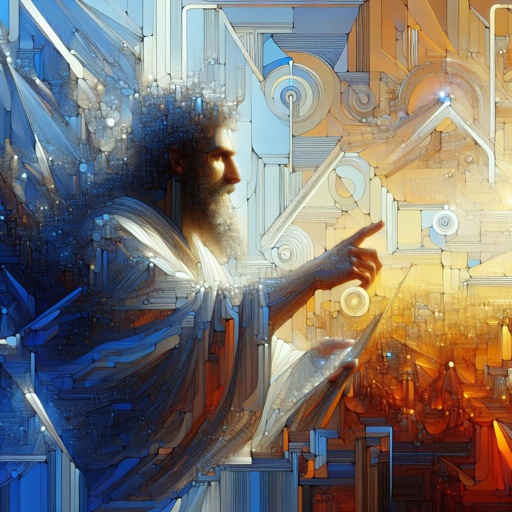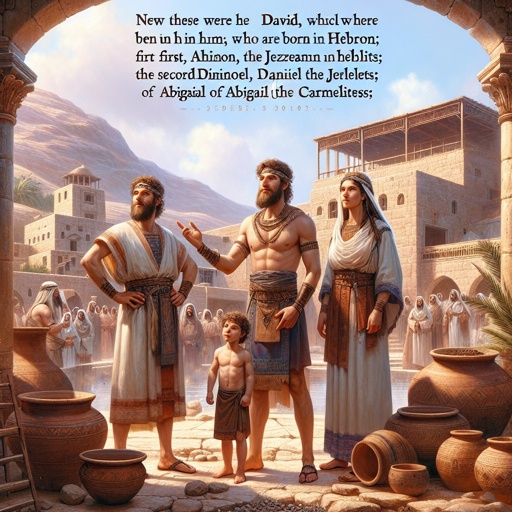What does Daniel 1:1 mean?
"In the third year of the reign of Jehoiakim king of Judah came Nebuchadnezzar king of Babylon unto Jerusalem, and besieged it." - Daniel 1:1

Daniel 1:1 - "In the third year of the reign of Jehoiakim king of Judah came Nebuchadnezzar king of Babylon unto Jerusalem, and besieged it."
An illustration from the biblical era: The third year of reputable monarch Jehoiakim's command over Judah, another significant public figure, the ruler of Babylon named Nebuchadnezzar, advances towards Jerusalem, imposing a seige. Capture the view of ancient Jerusalem from a distance, under a foreboding sky as the Babylonian forces approach. The architectural accuracy of the fortified city, the intensity of the gathering troops, and the tension in the air should be emphasized. This scene is to be depicted in a modern digital art style.
The book of Daniel opens with the verse Daniel 1:1 from the King James Version (KJV), which reads "In the third year of the reign of Jehoiakim king of Judah came Nebuchadnezzar king of Babylon unto Jerusalem, and besieged it."
This verse sets the stage for the entire book of Daniel, providing historical context for the events that are about to unfold. The third year of Jehoiakim's reign marked a pivotal moment in the history of Judah, as it was during this time that Nebuchadnezzar, the king of Babylon, launched an invasion of Jerusalem. The besieging of Jerusalem by Nebuchadnezzar resulted in the beginning of the Babylonian captivity, a period of exile and displacement for the people of Judah.
One of the primary themes of the book of Daniel is the sovereignty of God in the midst of political turmoil and uncertainty. The invasion of Jerusalem by Nebuchadnezzar and the subsequent exile of the Israelites could easily be seen as a demonstration of the power and might of the Babylonian empire. However, throughout the book of Daniel, we see God working behind the scenes, orchestrating events and fulfilling his purposes.
The context of Daniel 1:1 is significant in understanding the symbolic and prophetic nature of the entire book. The invasion of Jerusalem by Nebuchadnezzar and the subsequent exile of the Israelites were not merely historical events, but they also held symbolic significance in the larger narrative of God's plan for redemption and restoration. The book of Daniel contains numerous prophecies and visions that point to the future restoration of Israel and the coming of God's kingdom. The historical context of the Babylonian captivity serves as a backdrop for these prophetic visions, emphasizing the faithfulness of God in fulfilling his promises to his people.
Symbolism is also present in the verse Daniel 1:1, as it sets the stage for the larger themes of captivity and exile that are prominent throughout the book of Daniel. The invasion of Jerusalem by Nebuchadnezzar and the subsequent exile of the Israelites serve as a powerful symbol of the broken relationship between God and his people. The Babylonian captivity was a consequence of the Israelites' disobedience and unfaithfulness to God, and it serves as a reminder of the consequences of sin and the need for repentance and restoration.
Overall, Daniel 1:1 from the King James Version sets the stage for the larger narrative of the book of Daniel, highlighting themes of God's sovereignty, the prophetic nature of the text, and the symbolic significance of the Babylonian captivity. This verse serves as a powerful introduction to the book, laying the foundation for the events and themes that will unfold in the chapters to come. It reminds us of the faithfulness of God in the midst of political turmoil and uncertainty, and it points to the larger narrative of redemption and restoration that runs throughout the entire Bible.
Daniel 1:1 Artwork

Daniel 1:1 - "In the third year of the reign of Jehoiakim king of Judah came Nebuchadnezzar king of Babylon unto Jerusalem, and besieged it."

Daniel 1:21 - "And Daniel continued even unto the first year of king Cyrus."

Daniel 1:11 - "Then said Daniel to Melzar, whom the prince of the eunuchs had set over Daniel, Hananiah, Mishael, and Azariah,"

Daniel 1:6 - "Now among these were of the children of Judah, Daniel, Hananiah, Mishael, and Azariah:"

Daniel 1:9 - "Now God had brought Daniel into favour and tender love with the prince of the eunuchs."

Daniel 1:17 - "¶ As for these four children, God gave them knowledge and skill in all learning and wisdom: and Daniel had understanding in all visions and dreams."

Daniel 1:19 - "And the king communed with them; and among them all was found none like Daniel, Hananiah, Mishael, and Azariah: therefore stood they before the king."

Daniel 1:7 - "Unto whom the prince of the eunuchs gave names: for he gave unto Daniel the name of Belteshazzar; and to Hananiah, of Shadrach; and to Mishael, of Meshach; and to Azariah, of Abed-nego."

Daniel 1:14 - "So he consented to them in this matter, and proved them ten days."

Daniel 8:1 - "In the third year of the reign of king Belshazzar a vision appeared unto me, even unto me Daniel, after that which appeared unto me at the first."

Daniel 7:1 - "In the first year of Belshazzar king of Babylon Daniel had a dream and visions of his head upon his bed: then he wrote the dream, and told the sum of the matters."

Daniel 10:1 - "In the third year of Cyrus king of Persia a thing was revealed unto Daniel, whose name was called Belteshazzar; and the thing was true, but the time appointed was long: and he understood the thing, and had understanding of the vision."

1 Chronicles 3:1 - "Now these were the sons of David, which were born unto him in Hebron; the firstborn Amnon, of Ahinoam the Jezreelitess; the second Daniel, of Abigail the Carmelitess:"

Daniel 11:1 - "Also I in the first year of Darius the Mede, even I, stood to confirm and to strengthen him."

Daniel 1:16 - "Thus Melzar took away the portion of their meat, and the wine that they should drink; and gave them pulse."

Daniel 1:8 - "¶ But Daniel purposed in his heart that he would not defile himself with the portion of the king's meat, nor with the wine which he drank: therefore he requested of the prince of the eunuchs that he might not defile himself."

Daniel 5:1 - "Belshazzar the king made a great feast to a thousand of his lords, and drank wine before the thousand."

Daniel 6:1 - "It pleased Darius to set over the kingdom an hundred and twenty princes, which should be over the whole kingdom;"

Daniel 9:1 - "In the first year of Darius the son of Ahasuerus, of the seed of the Medes, which was made king over the realm of the Chaldeans;"

Daniel 4:1 - "Nebuchadnezzar the king, unto all people, nations, and languages, that dwell in all the earth; Peace be multiplied unto you."

Daniel 1:18 - "Now at the end of the days that the king had said he should bring them in, then the prince of the eunuchs brought them in before Nebuchadnezzar."

Daniel 2:1 - "And in the second year of the reign of Nebuchadnezzar Nebuchadnezzar dreamed dreams, wherewith his spirit was troubled, and his sleep brake from him."

Daniel 1:15 - "And at the end of ten days their countenances appeared fairer and fatter in flesh than all the children which did eat the portion of the king's meat."

Daniel 1:3 - "¶ And the king spake unto Ashpenaz the master of his eunuchs, that he should bring certain of the children of Israel, and of the king's seed, and of the princes;"

Daniel 1:12 - "Prove thy servants, I beseech thee, ten days; and let them give us pulse to eat, and water to drink."

Daniel 1:13 - "Then let our countenances be looked upon before thee, and the countenance of the children that eat of the portion of the king's meat: and as thou seest, deal with thy servants."

Daniel 6:1-4 - "It pleased Darius to set over the kingdom 120 satraps, to be throughout the whole kingdom; and over them three high officials, of whom Daniel was one, to whom these satraps should give account, so that the king might suffer no loss. Then this Daniel became distinguished above all the other high officials and satraps, because an excellent spirit was in him. And the king planned to set him over the whole kingdom. Then the high officials and the satraps sought to find a ground for complaint against Daniel with regard to the kingdom, but they could find no ground for complaint or any fault, because he was faithful, and no error or fault was found in him."

Daniel 1:10 - "And the prince of the eunuchs said unto Daniel, I fear my lord the king, who hath appointed your meat and your drink: for why should he see your faces worse liking than the children which are of your sort? then shall ye make me endanger my head to the king."

Daniel 3:1 - "Nebuchadnezzar the king made an image of gold, whose height was threescore cubits, and the breadth thereof six cubits: he set it up in the plain of Dura, in the province of Babylon."

Daniel 1:20 - "And in all matters of wisdom and understanding, that the king enquired of them, he found them ten times better than all the magicians and astrologers that were in all his realm."